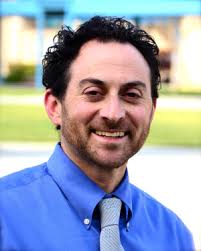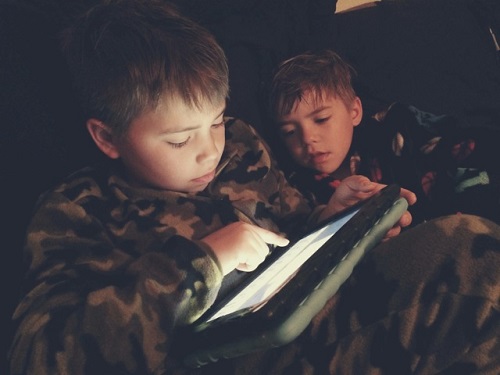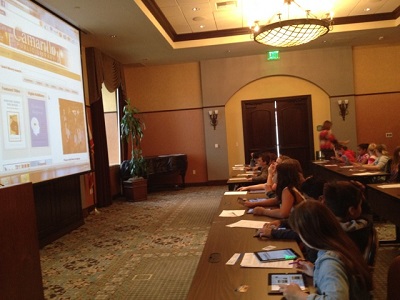
Jay Greenlinger All photos courtesy of Pleasant Valley School District
Jay Greenlinger knew there was little he could do to restore the school librarian positions that had been cut from his district. So he tackled what he knew best—ebooks, devices, online subscriptions, and technology—to support students’ access to materials for their learning.
“Most schools do not have a functioning library,” says Greenlinger, director of instructional technology at the Pleasant Valley School District (PVSD) in Camarillo, California. “It’s a great place to hold meetings or display student work, but it’s no longer a center of learning, no longer a hub.”
PVSD’s budget went from $65 million in the 2007-2008 school year to $49 million for 2013-2014, while the district gained about 600 additional children, he says. Cuts over the past six years meant fewer hours for custodians, afterschool positions, and library media specialists. Greenlinger, a former principal, had a full-time media specialist at the time. He had to split her time the second year and completely lost the budget for the position by 2011-2012. He transitioned to his current position in 2013; before that, he served as principal of Camarillo’s La Mariposa Elementary School for four years.
Noting that there was a shift in learning content toward digital materials, Greenlinger began to look at what was available online that could dovetail with school curriculum and allow students to, at least, find books and other resources. For the 2013-2014 school year, he launched a 1:1 iPad program in five elementary classrooms across the district at Title 1 schools, partnering with the public library and bringing 130 students to a local branch to learn how much they could get online through OverDrive on their devices.
“The kids were hooked, reading books on their iPads that morning,” he says. “One girl was distraught that Nancy Drew was not on OverDrive.”

Students reading off OverDrive.
That’s when Greenlinger knew he had a solution. With the school district allocating funds for Common Core implementation over the next two years, he drew from those resources, budgeting $65,000 for the 2014-2015 school year—and the same for the next—to build a high-interest digital stopgap containing non-fiction, fiction, and professional reading for both students and teachers.
Students at Las Colinas Middle School in Camarillo are already putting the library to use, accessing the OverDrive library on the school’s 106 Chromebooks and on their own mobile devices. The school is looking to add five more sets of 36 Chromebooks for the 2014-2015 school year, and the PTSA is also raising funds for additional devices for the 1,000 6-8 grade students, says the school’s principal, Pam Gonzalez.
“I will not say that we have a vast majority of students bringing their own devices at this time, but I see that growing,” she says. “The goal is to get more devices into the hands of kids.”

Students learning how to access material off OverDrive at the Camarillo Public Library.
Greenlinger is also transitioning two teachers to manage the new online library. This year, they worked one day a week growing the district’s online subscriptions, video content, and digital materials. Next year, they’ll be full-time, assigned as Teachers on Special Assignment on Digital Media Integration.
“Most of my time will be looking at what’s available to bring the best and most appropriate books into our library,” says Shirleen Oplustic, a sixth grade language arts and history teacher at Las Colinas. “I’ll also be promoting the library so students and teachers who aren’t aware now will know it’s there and know it’s able to be used.”
Already, every student in the district has an OverDrive account accessible from wherever they want to work. Greenlinger, concerned about ensuring kids having access from home (as 30 percent of the student body qualifies for free or reduced lunch), ran a technology survey in February 2014 within the community among grades 3 through 8. What he found reassured him. Ninty-five percent of students had wireless access from home, and therefore could connect to OverDrive from home even if that meant it would be through a parent’s tablet or e-reader. Now, his goal now is to find a way to fill that five percent gap.
“We don’t know what that means, but we recognize this is a solvable problem,” he says. “We’re going to see if there are any municipal partnerships we can form to solve it.”
What he’s also sure about is that while he’d love to see school librarians restored to his district—and across the state—he will at least focus on what he can do to ensure that the students he serves are not left completely without access. To him, that means staying on top of digital resources—so students can at least have the materials they need, when they need them.
“Everything is Web based,” he says. “This shift is content in classrooms is now going digital. You’re either all in with that, or left behind.”



Kudos to Mr. Greenlinger for making the most of an unfortunate situation. I disagree, however, with the “Everything is Web based” quote.
As a librarian who uses OverDrive for collection development for elementary school students, I find that it is very difficult to get books for younger readers and by diverse authors available through digital lending platforms. You have access to some of the award-winners, but an active search for books by diverse authors or with diverse protagonists will show that oftentimes these books, like Nancy Drew, are not available. No format is all-inclusive right now. Variety ensures access.
I am glad Mr. Greenlinger is doing something to bridge the gap. How heartbreaking for those students not to have a librarian in their school. I can’t imagine cuddling with my preschooler before bedtime with an ipad or electronic device to share a story. I hope these parents will promote the love of picture books, chapter books in print format by visiting their public libraries (if they have one, that is). I think we are witnessing the death of part of our culture. It is very sad.
I am curious, they put the money into ebooks which in essence they do not own? My understanding is an Overdrive account is similar to a subscription, and if they don’t renew they lose out on the investment. Also what about the cost of maintaining and upgrading the ereaders and Chromebooks. And a teacher on special assignment is a librarian of sorts, yes? So why not have the librarian? Why not partner with the local library?
I agree with Ms. Gall, that it is admirable he understands how vital the link is to bridge children to literature, but confused on the math. In the long run is this really the ‘cheaper’ alternative?
In some senses I think it is a call to action on librarians to make sure we understand the needs of the school system, but also for us to continue to communicate clearly all the ways we help children be great readers, critical thinkers, problem solvers and innovative leaders of the future.
I agree with what Elisa Gall says about Overdrive selections or selections from any e-content vendor for that matter – no format is all-inclusive, and many worthy titles are not available for e-readers.
I agree with Tracy as well–it IS a call to action on librarians, but unfortunately this call has been sounding loudly for a number of years now and few seem to hear it. And of course there are many studies that prove again and again the positive impact a school library and qualified LMS has on student achievement http://www.lrs.org/data-tools/school-libraries/impact-studies
Given what we know, if, after all these years we still aren’t reaching the people who might be able to make a difference, we need to step in a make a difference ourselves, by advocating to get libraries and librarians back into schools.
Things just don’t add up here. So there is no $ for a librarian, but there is money for TWO full time classroom teachers to essentially do a librarian’s job. I think the move from print to digital for young children is the wrong course. Where is the research (from someone other than a technology company) that supports this?
Some food for thought:
http://nyti.ms/1qm5O3d
http://www.roughtype.com/?p=3590
http://www.theguardian.com/books/2013/nov/25/young-adult-readers-prefer-printed-ebooks
http://www.nngroup.com/articles/ipad-and-kindle-reading-speeds/
http://www.scientificamerican.com/article/reading-paper-screens/
Thank you Michelle for pointing out that the Emperor is naked. CA has 800 LMTs for 10,000 schools. — the worst librarian to student ratio in the nation. We have deprived our kids of both school and public libraries and have low reading scores as a result. We would have to build 1000 public library branches to be average. Stories like this make people think everything is going to be OK.
That closing line leaves a lot of people, most specifically students and teachers, behind. I can’t imagine districts with dwindling budgets and families who live in those districts will be able to afford or support quality digital content in the not so long run. And how about instead of moving teachers out of the classroom and into the library, creating a new set of staffing problems, they keep or hire well trained librarians?
The part of this story that is most disturbing is not only do students loose out on the library experience, but teachers have asked over and over again for their library to be reinstated and it falls on deaf ears by the administration. They think they are creating a “state of the art district.” Thank you for all your responses. Maybe someone will get through to them.
I was once a librarian at La Mariposa where Mr. Greenlinger was a principal before I moved on to a middle school in the district then out of the district to a place that placed value on librarians. I still regularly see teachers from that school and they always tell me how sad it is to see a once vibrant library, disorganized, cluttered and ineffective so they don’t use it. Some do but many do not. Most of them are embracing the technology that they are being told to use but still lament over the loss of the a once upon a time place where the students eagerly visited every week…all 36 classes and with enrichment activities thrown in for their enjoyment.
A high school senior who was a student of mine read to students last summer at our local library. She read with enthusiasm and with enjoyment and did a wonderful job. When asked about her style she said she loved her school librarian and looked forward to her visits every week to listen to me read and get new books. Sadly, memories like that will not be the case for the current crop of PVSD students.
Technology is great and has it place but it will never replace all the warm fire breathing library dragons out there who put their hearts and souls into their jobs as I did and all my peers.